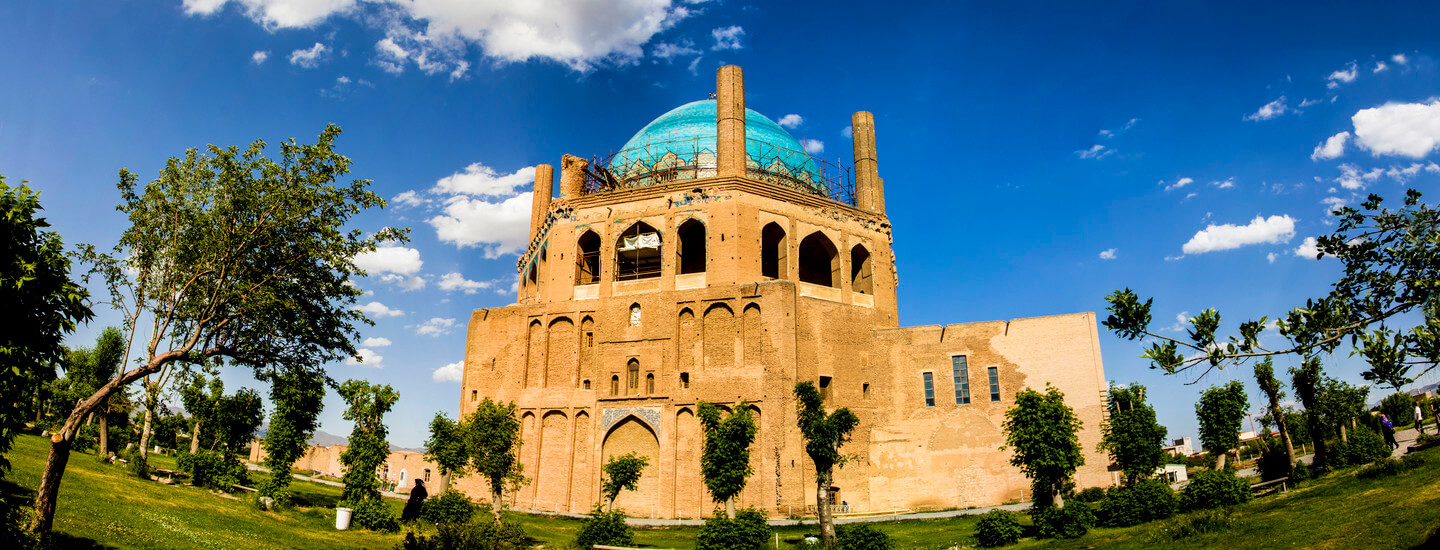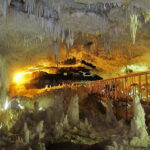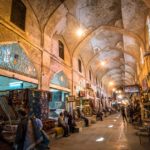Zanjan
On a high plain, surrounded by stark, eroded hills, the modest city of Zanjan makes the perfect base for wider explorations. The architectural wonder of Soltaniyeh is nearby, while the battered hoodoos of Behestan Castle and the bizarrely striped Colourful Mountains lie further afield. Enticingly scenic roads radiate to Khal Khal and the Caspian, the subterranean delights of the Katale Khor Caves, and the superbly lonely Takht-e Soleiman ruins.
Zanjan’s moment of infamy came in 1851 with a bloody siege ordered by Persian Prime Minister Amir Kabir. The resulting massacre was part of the relatively successful campaign to crush the nascent Baha’i religion. Baha’ism had only broken away from Islam three years before, but it was spreading much too rapidly for Tehran’s liking.
Tourist attractions are located all across the province and can be classified as natural, social, historic, and cultural. In this regard, a town such as Zanjan is hosts to the most number of these attractions.
Perhaps the most prominent site in the province is the magnificent edifice of The Soltaniyeh Dome which is one of the most exceptional and famous Islamic sites dating back to 700 years ago.
The Dome is listed in UNESCO world heritage and plays a great role in the tourism of the region.

Soltaniyeh Dome
Zanjan Location:
According to the last state divisions this province has 3 provincial districts, 13 regions, and 8 towns. In November 1996, the population of this province was approximately 901,000; out of which about 47% resided in urban areas, around 52% were rural dwellers, and a number were non-residents.
It was located on Commercial Silk road and is one of the few cities with no clear historical identity and identity and written memory of history don’t much talk about the historical, social, scientific, artistic and cultural information of Zanjan.
Zanjan Handicraft:
Zanjan; the World City of Filigree Work
This city is the capital of one of the western provinces of Iran owes its reputation mostly to making the unique handicrafts is so far as some handicrafts are recognized specifically by the name of this city. Until the late of 1398 SH about 45 active handicraft disciplines have been introduced in Zanjan among which the traditional knife making and filigrees are the most important local and highlighted handicrafts.
Meanwhile, the project of filigree work succeeded to meet all standards of authenticity, high quality, historical background, innovation and creativity defined by World Handicrafts Council and be inscribed on the list of UNESCO world cities as “Zanjan: World City of Filigree” in Bahman 1398 SH (January 2020).
Zanjan
This art-craft had been popular in this city from thousands of years ago in so far as Zanjan is currently reputed as the birthplace of filigree work. The main material of filigree is silver. After transforming into the very thin wires that called silver threads due to their high tenuity, the artist makes complicated and delicate patterns using them. Jointing these silver wires together produces different volumes, decorative or functional, such as tea service, chocolate wares, vase, candlestick, photo frame, jewelry box, and various jewelries.
Using filigree work in mixed products are of the innovations of Zanjan artists; they use the delicate filigree flowers and arabesques for decorating the upper layer of knifes’ handle and in doing so they create a local and unique mixed artwork. The important point in making Zanjan filigree is doing the whole process by hand, without using industrial methods. Considering this principle, the final product may surprise the viewer by this degree of elegance and delicacy. Due to the high purity of silver used in making these products, the shininess of filigree works is unexampled.
At present, about 230 filigree artists are active in 50 workshops in Zanjan. The authenticity of this handmade artworks in Zanjan is to such extent that some other cities like Tehran and Isfahan owes their filigree skills to the artists of Zanjan. In addition to the workshops, many other centers are now active in education, supply and sale of filigree works. This has led to a wide employment of different groups of people in Zanjan in this field.
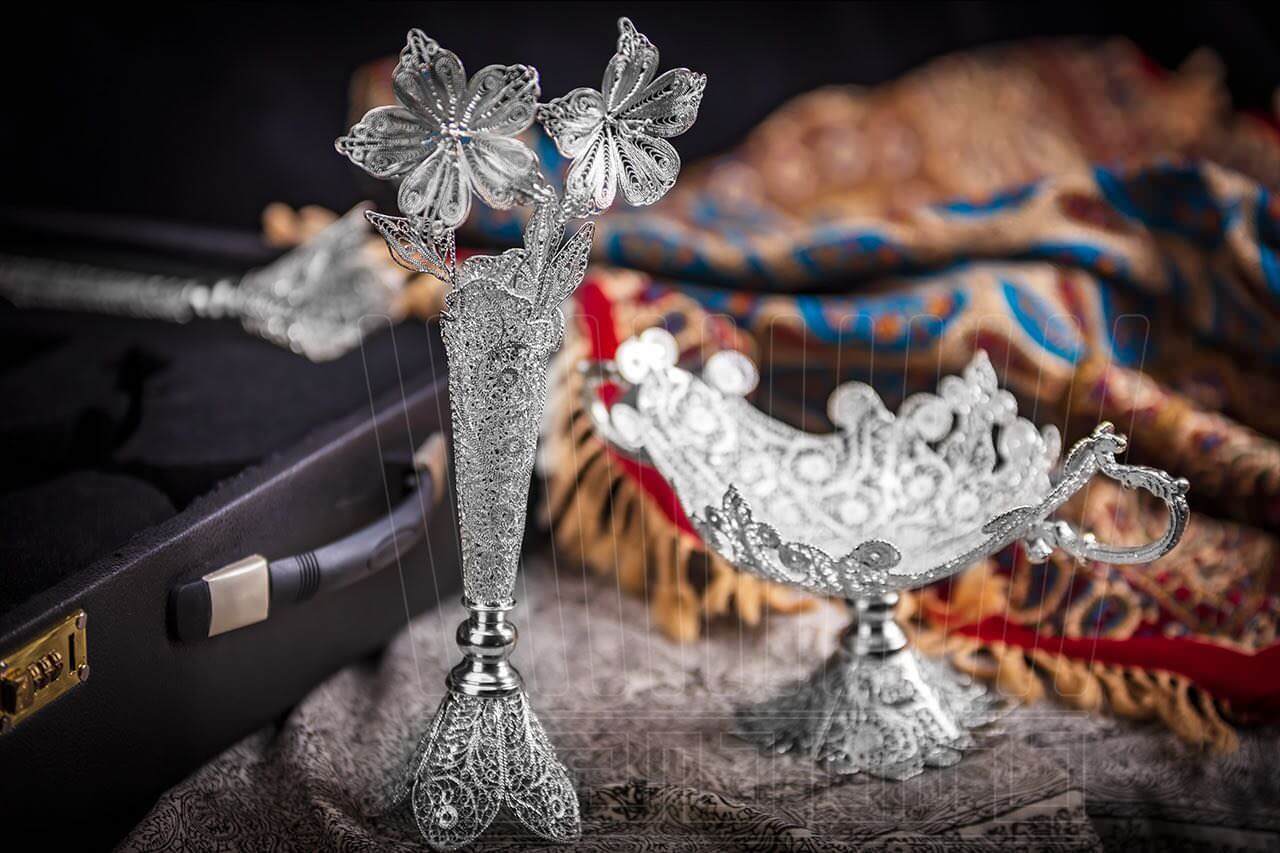
Filigree Work
Zanjan Attractions:
Soltaniye dome:
Soltaniye Dome is a UNESCO World Heritage site, the third largest dome in the world after Santa Maria Dome and Hagia Sophia Dome and the largest brick made dome in the world.
Haj dadash bathhouse:
One of the oldest buildings in Zanjan, Haj Dadash Bathhouse is located in the Zanjan Bazaar complex. This century-old bath house has a dome that sits on four stone pillars, carved by master stonemasons from Hamadan. After renovation and minor changes to the original structure, Haj Dadash Bathhouse was turned into a traditional Restaurant.
Rakhtshurkhaneh:
Zanjan Wash House or as it is known locally Rakht-Shouy Khaneh is located in the old Abass-Qoli neighborhood of the city and was built in 1928 by the then mayor of the city Ali Akbar Tofiqi to provide the women of the city with a closed space to do their laundry. This Qajar era (1785-1925) structure has been built entirely of brick and stone. The Wash House consists of two parts Managerial Quarters and Laundry Room. The Managerial Quarters consists of a residential building and a courtyard with trees and flowers.
Consequently, An entrance in the northern part of the courtyard connects the residential building with the laundry room. Zanjan Wash House has a 17-meter long and 11.5-meter wide Khazineh, a room with a large hot water pool, which has an 8-meter high ceiling. A terrace-like platform has been built directly across from the laundry room, where the manager of the Wash House would sit and oversee the business. In conclusion, A nearby Qanat (underground water management system) provided water for the Wash House. Zanjan Wash House turned into an Anthropology Museum in 1998
Kervansaray Sangi:
The Sangi Caravanserai (Stone Caravanserai) is a Safavid dynasty caravanserai located in Zanjan city The caravanserai is the oldest remained monument in Zanjan city. It has a four iwans (porches) plan and its chambers (Persian: hojrehs) are located on one floor.
subsequently, The ceiling of the caravanserai is arcade. Using of stone as the main material in the building, is caused that the caravanserai is became famous as Stone Caravanserai. This 400-year-old stone building is an L-shaped remnant of a caravanserai with 10 carpet-decked vaulted alcoves facing a long row of tables. certainly, Sangi caravanserai was registered in national index in 1998 by the Iranian Cultural Heritage Organization with number 2128.
Mirbaha Bridge:
The century-old Mir Baha-ol-Din Bridge or Old Bridge is the oldest and largest standing bridge on the Zanjan River (Zanjan Roud) which was built in the Qajar era (1785-1925) by a merchant of the same name. This brick bridge is 100 meters long and 7 meters wide.
in addition, The highest point of the bridge is 11 meters from the water. The bridge has a large middle arch with two smaller arches on either side. In conclusion, This bridge was registered as a National Heritage Site in 1977.
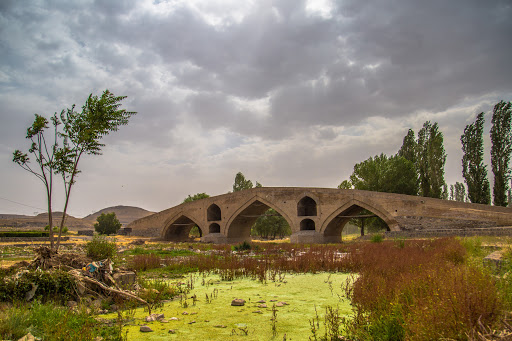
Mirhaba Bridge
Sohrein protected area:
Persian gazelle (Gazella subgutturosa) is one of the most important species in the world. Therefore, The gazelles in Sohrain plain in Sorkhabadits wide distribution in Iran associated with protected region in Zanjan province.
Jame mosque of Zanjan:
subsequently, Jame’ Mosque is in the old part of the city. Abdollah-Mirza Dara, son of the Qajar monarch Fath- Ali Shah commissioned this mosque. Existing sources also refer to this building as the Seyyed Mosque and the Seyyed Madrasa. The original building of the mosque dates back to the first half of the thirteenth century In the Pahlavi period.
Above all, When the avenue was built along the northern side of the mosque, its entrance was altered and the vestibule behind the northern Ivan was demolished .before that, the courtyard was accessed through the vestibule and two corridors flanking the Ivan, whereas now entry is gained directly through the northern Ivan. At the same time as these alterations were made two minarets were erected on either side of the portal to 1959.
during this year, two minarets once again rebuilt it. In addition, reading room and library added to the building. The courtyard of the mosque had vast, lush flower beds which its custodians removed around 1961 to prevent further moisture infiltration into the building. in addition, Later on, in 1989, the flower beds revived to a limited extent. In recent years, the chambers surrounding the courtyard and the northern and eastern Ivan.
Moreover, Iranian Cultural Heritage Organization restored It and parts of the building’s collapsed tile- work rebuilt. The mosque contains four Ivan on the sides of a large open court. To the east and west of the court sixteen chambers exist running parallel to each other. Also, Facing towards south are more chambers as residential quarters for theology students. These chambers have vaulted and arched ceilings decorated with artistic tile work. The mosque has four sanctuary, or night prayer halls, each containing a pulpit.
Shilander village:
Shilandar village is located 40 km far from Zanjan. The village has stepped architecture and is one of the most beautiful villages in the province and after passing through the village of Aliabad and Taham. The architecture of the village is the same as Masule village in the mountainous tissue. in other words, Abundance of waterfalls has added to the beauty of the countryside meanwhile the nature and lush area also catch the eye of the viewer.
However, Shilandar village Shilandar village Shilandar village 64 km far from Zanjan is located. The village is one of the most beautiful villages in the province. The architecture of the village is the same as Masule village in the mountainous tissue has been astounding. Waterfall is abundant, has added to the beauty of the
Archaeology museum:
Consequently, The Archeology Museum of Zanjan is located in the Zolfaqari Mansion of Zanjan and opened in 2009. This museum houses artifacts from prehistory, ancient history and the Islamic era. So far six salt mummies from the Achaemenian and Sassanid eras found. One of these mummies is at the National Museum of Iran in Tehran.
Salt men:
The Archeology Museum of Zanjan is located in the Zolfaqari Mansion of Zanjan and opened in 2009. This museum houses artifacts from prehistory, ancient history and the Islamic era. So, It found far six salt mummies from the Achaemenian and Sassanid eras. in addition, One of these mummies is at the National Museum of Iran in Tehran.
Mirzaei mosque:
This mosque is one of the oldest religious buildings which has been remained safe and is located in Bazaar region. It built at the end of Safavid and beginning of Qajar eras. However, This mosque has two sections, old middle aisle and new mosque . Mirzaee Mosque Mirzaee Mosque: This mosque is one of the oldest religious buildings which has been remained safe and is located in Bazaar region. in addition, It built at the end of Safavid and beginning of Qajar eras. This mosque has two sect
Hosseinieh:
Meanwhile, The hosseinieh of Zanjan is a place for religious gatherings and ceremonies. Mourners dressed in black take to the streets or gather in the hoseyniyeh to grieve the slaying of Imam Hossein . The Imam flatly refused to give allegiance to the oppressive Umayyad caliph, Yazid.
Above all, His martyrdom took place on the tenth of the Muslim month of Muharram, known as Ashura, in 680 AD. He martyred along with 72 of his loyal companions in the tragic massacre at Karbala. The Shi’ah commemorated during an annual 10-day period held every Muharram as well as many Sunnis, culminating on its tenth day, Ashura.
Papayi ski piste:
Consequently, Papayi Ski Resort is located 20 kilometers from Zanjan on the road to Bijar. This resort has a ski school, 2 ski lifts, parking space for skiers and a restaurant where they can have a snack after a day on the piste (ski-run). Papayi has a vertical drop of 600 meters and an altitude of 21,150 meters above sea level.
Goljik Cave:
Above all, Goljyc cave 35 km southwest of Zanjan city in Goljyc village is located. This is huge natural erosion limestone cave in the cave and emerged with a pleasant climate inside the refuge of pre-history. Its dimensions are 100 × 700 m and a height of approximately 50 meters.
Therefore, Man cave biological effects belonging to the 16 to 30 thousand years BC shows. Inside the cave, tools, equipment, bits of stone and bones of prey animals can be seen in abundance. What is most worthy of study, study and important works of architecture in the cave and closed the living spaces and privacy rose in its ownership.
GET AROUND ZANJAN
most importantly, Useful shuttle taxis run from Enqelab Sq to Honarestan Sq, passing near the bus terminal. Others go from Sabz Sq to Esteqlal Sq.
certainly, Traveling by taxi in Zanjan is easy and inexpensive. A shared taxi costs around 30,000—50,000 rials and private hire costs up to 100,000 rials, depending on where you are going.
